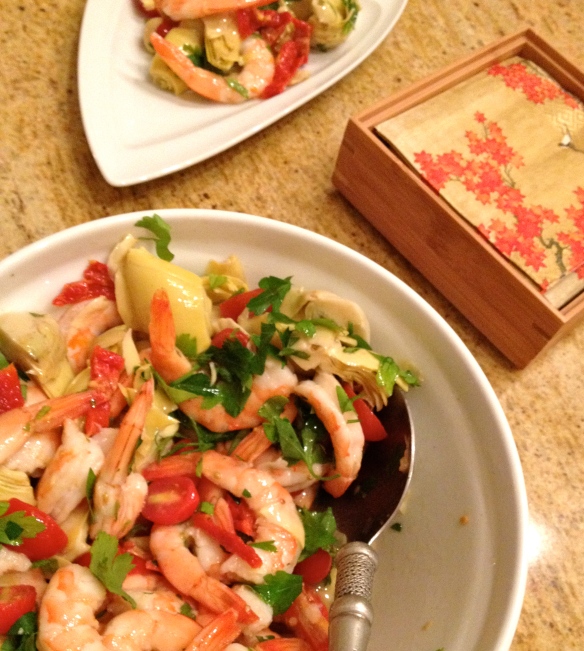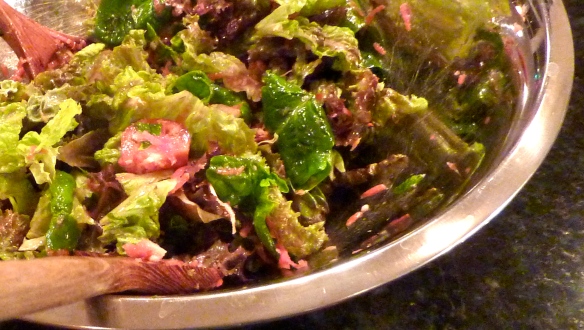Vinaigrette, as the word suggests, comes to us from the French. According to famed French chef, Auguste Escoffier (1846-1935), who documented the essentials of French cooking for us, this simple “cold sauce” should be used to accompany “calf’s head or feet”. Auguste might be surprised to know that, while the vinaigrette has endured to grace our tables more than a century after his writings, his recommended application is no longer a common use. I must admit that I prefer my vinaigrette on something other than calf’s feet.
So, what should we do with a vinaigrette? There are so many applications beyond salad dressing. One of my inspirations, Paul Virant, at Vie http://www.vierestaurant.com/, is a master at using vinaigrettes as well as other acid-containing foods (such as pickled fruits, vegetables, etc) and taught me that acid-containing foods are delightful complements to rich flavors. So, do not limit yourself to a salad vinaigrette. Try it with roasted vegetables, in a pasta or rice salad, as a meat marinade for grilling, on cold meats/seafoods, as a contrast to rich, sautéed foods (e.g., seared scallops), etc.
But I digress. Let’s go back to the vinaigrette and the basic components — what they are, why they are, and how much to use:
VINEGARS
When it is time to make a vinaigrette, do NOT reach for that bottle of white vinegar on your pantry shelf. It may be fine for other cooking purposes (although I can’t think of many), but it simply will not do when you are using it as a main flavor ingredient in a cold sauce. Vinaigrettes require a good quality, aged, wine vinegar. My favorites are a aged sherry, champagne or riesling vinegars. Look for ones aged in barrels previously used for other purposes (e.g., making whiskey) as this will add complementary flavors. With few exceptions, I don’t like vinegars with added flavors (e.g., tarragon vinegar, etc) as I like to add extra flavors myself.
EMULSIFIERS
Oil and vinegar, as you know, are not friendly to each other. When you mix them, they each stay on one side of a horizontal “line”. Emulsifiers serve as a bridge to link the molecules of oil and vinegar together — keeping them from retreating to their respective sides of the “line”.
- COOKING FUNDAMENTALS: EMULSIFIERS. Emusifiers are chemicals that have a portion of a molecule that is soluble in water and another portion that is soluble in oil. This property allows them to happily exist on the border between water and oil, thus stabilizing the small droplets that form in a “mixed” emulsion – such as a shaken vinaigrette. A number of foods make good emulsifiers. Egg yolks are typical and responsible for creating the emulsion in mayonnaise; but you won’t find raw eggs in a classic vinaigrette. Instead, use mustard and/or honey as emulsifiers. These will also double as flavoring agents.
ADDITIONAL FLAVORING AGENTS
This category has virtually unlimited choices. These can be used strictly to add flavor, but also to soften the sharpness of the vinegar. Some of my favorites are capers, shallots, tarragon, garlic, verjus (unripened grape juice), lemon juice, blood orange juice, and pear nectar — although not all mixed together!
OILS
Going back to our French chef, Escoffier, he recommends a mix of 3 parts oil to 1 part vinegar — a ratio still considered standard in the culinary world. I find this is too much oil. The use of a good vinegar, a bit of sweetness (honey), and some added flavors will soften the sharpness of the acid and require less oil. Olive oil is a time-honored favorite, but grape seed, nut and truffle oils are also great choices — although some of these (particularly truffle) should be used in small quantities — as a supplement to other oils. As with vinegars, good quality is important. Save your best oils for vinaigrette; use the cheaper ones for sautéing.
Basic Vinaigrette
——————————————————————————–
Recipe By: A Global Garnish, LLC
Serving Size: 12
1 each Shallots, trimmed and minced
2 teaspoon Dijon mustard
2 tablespoon Honey
1 teaspoon Salt, kosher
1/2 teaspoon Pepper, black
3 ounces Vinegar, wine, aged
5 ounces Oil, olive ; more to taste
Added flavor ; verjus, lemon juice, truffle oil, etc
Directions:
1. Trim tough purple layers from shallot. Mince fine.
2. In a mixing bowl, whisk together the mustard, honey, salt, pepper, vinegar, and shallot.
3. Whisking constantly, very slowly drizzle in the olive oil. Add additional flavor as desired. Adjust seasonings.
4. Store, tightly covered, in the refrigerator. Allow vinaigrette to warm to room temperature before using.
Notes:
SERVING VINAIGRETTE WITH SALAD: Before serving, add to greens in mixing bowl and toss well. Plate in mounds and garnish with colorful ingredients. The idea is to get a light coating on the salad components, which requires tossing before serving – rather than drizzling dressing at the table.
OIL TO VINEGAR RATIO: A “standard” vinaigrette is 3 parts oil to 1 part vinegar. When adding other flavorings (juice, honey, etc), you can use less oil for a lighter and healthier dressing without sacrificing taste.
ITALIAN VARiATION: Add 2 cloves minced garlic, 2 minced anchovy fillets and 1 T fresh (or 1 t dry) oregano. Substitute balsamic for half of the wine vinegar. Omit optional flavors (verjus, lemon, etc.).



Just what I’ve been waiting for, thank you.
I’ll expect to see some on your table when I arrive in a few weeks. Actually, I don’t care what you serve, as long as I get to see YOU!
Looks yummy, Jeannee!
Pingback: Michigan’s Bountiful Agricultural Harvest and a Summer Salad | A GLOBAL GARNISH